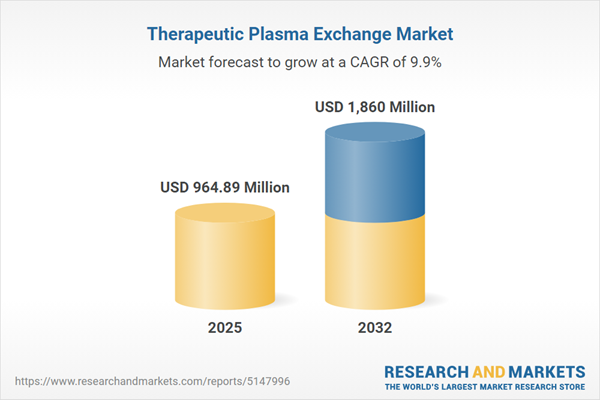Speak directly to the analyst to clarify any post sales queries you may have.
Senior decision-makers in the therapeutic plasma exchange market navigate a rapidly evolving environment where regulatory shifts, advancing technologies, and changing clinical needs directly inform organizational strategy. Strategic decisions in this sector depend on precise, actionable market intelligence tailored to leadership priorities.
Therapeutic Plasma Exchange Market Snapshot
The therapeutic plasma exchange market is projected to reach USD 878.53 million in 2024, supported by a compound annual growth rate of 9.90%. Expanded use of plasma exchange procedures highlights the continued adoption in both well-established and emerging healthcare systems. Automation in plasma exchange platforms is now central, enhancing operational efficiency and improving patient outcomes. Industry leaders are forging strategic partnerships to broaden therapy access, standardize protocols, and integrate systems, enabling consistent care delivery across diverse healthcare networks. Ongoing collaboration between providers, manufacturers, and technology specialists is strengthening scalable frameworks, improving care reliability and resource allocation.
Scope & Segmentation of the Therapeutic Plasma Exchange Market
For senior executives, understanding the distinct scope and segments of the therapeutic plasma exchange market informs investment and operational alignment. Each segment shapes procurement decisions, service delivery frameworks, and competitive approaches in this complex landscape:
- Applications: Therapeutic plasma exchange addresses needs in autoimmune, neurological, renal, and hematologic conditions, supporting broad clinical strategies from acute interventions to long-term management.
- Procedure Types: Centrifugation-based and membrane-based technologies offer flexible solutions, allowing healthcare teams to select protocols that suit specific patient profiles and facility workflows.
- Product Types: Essential consumables—including anticoagulants, replacement fluids, and tubing—align with modular and integrated device platforms that enable scalable and connected care models.
- End Users: Hospitals, specialty centers, and clinics drive adoption and shape procurement patterns, influencing operational models and technology adoption rates within their networks.
- Regions Covered: North America, Latin America, Europe, Middle East, sub-Saharan Africa, and Asia-Pacific each bring unique regulatory landscapes, infrastructure maturity, and technological readiness, leading to region-specific opportunities and challenges.
- Leading Companies Profiled: Key organizations—including Baxter International Inc., Fresenius Kabi AG, and Terumo Corporation—focus on product safety, streamlined logistics, and ongoing technology advancements, supporting evolving clinical and operational needs.
Key Takeaways for Senior Decision-Makers
- Continued technological development expands the scope and complexity of therapeutic plasma exchange applications, making advanced procedures more accessible in diverse clinical settings.
- Updated reimbursement models and regulatory policies open avenues for organizational advancement, particularly in specialized treatment areas and emerging markets.
- Increasing multidisciplinary collaboration between fields such as neurology and immunology results in more comprehensive care pathways and efficient patient management strategies.
- Strategic partnerships between solution providers and healthcare organizations fast-track the rollout of tailored plasma exchange solutions and accelerate adaptation to local clinical environments.
- Growing focus on digital integration and value-based sourcing supports operational stability, clear cost structures, and improved standardization, especially under variable resource conditions.
Tariff Impact and Supply Chain Strategies
Upcoming US tariffs in 2025 on essential consumables necessitate proactive supply chain strategies among healthcare providers and suppliers. Organizations are fortifying resilience by deepening supplier relationships, refining inventory management, and adopting adaptive manufacturing processes. These measures help ensure continuous access to plasma exchange products despite regulatory fluctuations.
Methodology & Data Sources
This market report utilizes peer-reviewed clinical literature, current regulatory guidelines, and targeted market surveys. Analytical methods combine both top-down and bottom-up models, reinforced with proprietary benchmarking, to deliver robust forecasting and reliable insight for executive planning.
Why This Report Matters
- Equips executive teams with actionable market intelligence for compliance, targeted segmentation, and data-driven strategy alignment.
- Enables agile decision-making in response to evolving clinical, operational, and regulatory pressures.
- Offers recommendations that prioritize patient care optimization while supporting organizational growth and competitiveness in the therapeutic plasma exchange sector.
Conclusion
Focused intelligence empowers business leaders to adapt confidently, recognize emerging market trends, and uphold a strong competitive stance as the therapeutic plasma exchange sector continues to develop.
Additional Product Information:
- Purchase of this report includes 1 year online access with quarterly updates.
- This report can be updated on request. Please contact our Customer Experience team using the Ask a Question widget on our website.
Table of Contents
3. Executive Summary
4. Market Overview
7. Cumulative Impact of Artificial Intelligence 2025
Companies Mentioned
The companies profiled in this Therapeutic Plasma Exchange market report include:- Baxter International Inc.
- Fresenius Kabi AG
- Terumo Corporation
- Haemonetics Corporation
- B. Braun Melsungen AG
- Nipro Corporation
- Asahi Kasei Medical Co., Ltd.
- Kaneka Corporation
- Grifols, S.A.
- MacoPharma S.A.
Table Information
| Report Attribute | Details |
|---|---|
| No. of Pages | 191 |
| Published | November 2025 |
| Forecast Period | 2025 - 2032 |
| Estimated Market Value ( USD | $ 964.89 Million |
| Forecasted Market Value ( USD | $ 1860 Million |
| Compound Annual Growth Rate | 9.9% |
| Regions Covered | Global |
| No. of Companies Mentioned | 11 |









